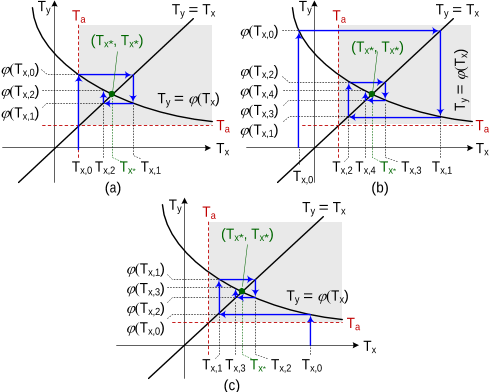0885-8993 (c) 2018 IEEE. Personal use is permitted, but republication/redistribution requires IEEE permission. See http://www.ieee.org/publications_standards/publications/rights/index.html for more information.
This article has been accepted for publication in a future issue of this journal, but has not been fully edited. Content may change prior to final publication. Citation information: DOI 10.1109/TPEL.2019.2915029, IEEE
ta
Thermal resistance from the top case of the chip to the
ambient (
o
C/W)
via
Vertical thermal resistance of a via array (
o
C/W)
via,n
Normalized vertical thermal resistance of a via array
v,ij
Vertical thermal resistance between copper layers of
outer-zone vias (
o
C/W)
Convective heat transfer parameter depending on PCB
geometry and orientation
Stefan-Boltzmann constant
= 5.670367×10
−8
(W⋅m
−2
⋅K
−4
)
Time (s)
Via diameter (m)
opt
Optimal via diameter (m)
ea
Equivalent thermal resistance from the FR4 zone edge
(r = r
e
) to the ambient (
o
C/W)
sa
Equivalent thermal resistance from the copper zone
edge (r = r
s
) to the ambient (
o
C/W)
ta
Equivalent thermal resistance from the top case of a
package to the ambient (
o
C/W)
I. INTRODUCTION
The volume of modern power semiconductor devices (e.g.,
GaN transistors) are continuingly shrinking in order to achieve
higher power densities, lower parasitic inductances, and lower
power losses [1]-[3]. However, thermal management has been
identified as the main barrier for further power density increase
[4]. The heat generated inside the miniaturized semiconductors
must be effectively dissipated to the ambient; otherwise, the
high junction and board temperatures may cause serious
reliability issues to the semiconductor, solder, thermal grease,
and printed circuit board (PCB) [5]-[8]. In addition, suitable
heat dissipation measures should be considered as early as in
the design and development phase, because subsequent
modifications are generally more costly and involve increased
engineering effort [9], [10].
In medium power applications, the surface-mounted devices
(SMDs) are normally cooled by a heatsink attached to the PCB,
where the thermal via array provides an effective thermal path
for the heat transfer [11]-[13]. In low power scenarios, a PCB
copper pad is typically used for heat spreading, and the SMD
can be cooled by natural convection [14]. Many reference
thermal designs can be found from device manufacturers’
websites [14]-[18]. However, several problems remain:
1) the thermal design guidelines recommended by
manufacturers are not optimal, and they are applicable for
specific packages only [15], [16];
2) inconsistent guidelines; for instance, the thermal via
diameter should be designed as large to reduce the thermal
resistance according to [16]; however, [15], [17] and [18]
recommend smaller via diameters and adopt different via
pitches.
Although the computational fluid dynamics (CFD)
simulations feature high accuracy, the model generation time
and computational cost could be fairly high [14]. Moreover,
CFD simulators are expensive and they are not always available
for electrical engineers. Therefore, it is necessary to develop
analytical models which enable fast and accurate design
optimization for thermal vias and pads.
In the literature, many efforts have been devoted to the
optimization of PCB thermal vias. The research in [19]-[21] is
based on either experimental results or CFD simulations; thus,
not all design scenarios are explored, but only some general
design guidelines are provided for specific applications.
Analytical thermal models of vias are built in [11], [22]-[25];
unfortunately, only partial parameters are analyzed, and no
optimal via design is derived.
For the PCB heat transfer characteristics, the heat conduction,
convection and radiation all exist, which makes the thermal
analysis complicated. Texas Instruments have developed an
online PCB thermal calculation tool based on CFD thermal
resistance data of different package sizes and pad dimensions
[26]. However, some important factors (e.g., the PCB thickness,
number of copper layers, and copper thickness) are not taken
into account, and also the online tool does not support design
optimization. In addition to the CFD simulations, some other
numerical calculation methods are developed [27], [28]. The
study in [28] deals with a substrate for a ball grid array package,
where a belt of densely populated vias and two continuous
copper layers are placed; however, the model is complicated
and no CFD or experimental verifications are provided. For
electrical engineers, it is more desirable to have an analytical
thermal model such that the temperatures of devices with
different designs and cooling methods can be fast predicted [29],
[30]. In [14] and [31], an analytical thermal resistance model is
developed for PCB thermal pads; however, the heat transfer
boundary and the convective heat transfer coefficient variation
over the temperature difference are not included, causing
potential errors between calculations and measurements.
This paper proposed two new analytical thermal models for
PCB vias and thermal pads, respectively. For the thermal model
of PCB vias, a systematic parametric analysis is firstly
conducted, which leads to a simplified thermal resistance model.
An optimal design trajectory is then obtained for PCB vias with
different specifications. After that, an analytical axisymmetric
thermal resistance model is proposed for PCB thermal pads.
Taking into account the interdependence between the
convection/radiative heat transfer coefficients and board
temperatures, a simple algorithm is developed to size thermal
pads at different PCB parameters, power losses, ambient
temperatures, and allowed maximum junction temperatures.
Finally, CFD simulations and experimental measurements
verify the developed analytical thermal models. The proposed
models enable electrical engineers to optimize their PCB via
design and thermal pad sizing at lower cost and less time effort.
II. THERMAL MODELING AND DESIGN OPTIMIZATION OF PCB
VIAS
A. Thermal Modeling of PCB Vias
A cluster of PCB plated through holes (PTHs), i.e., vias, can
provide an effective thermal path, which helps to transfer heat
from an SMD (chip) to a heatsink. The vertical structure of a
multilayer PCB with vias is shown in Fig. 1(a). The via
diameter, via-to-via spacing, and via plating thickness are
denoted as
, s, and t
PTH
, respectively. The number of copper
layers and the copper layer thickness are represented by N
Cu
and
t
Cu
, respectively.















